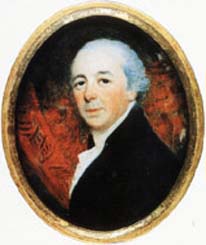John Nash (architect)


John Nash (18 January 1752 – 13 May 1835) was an Anglo-Welsh architect responsible for much of the layout of Regency London.
Early life
Born in Lambeth, London, as the son of a Welsh millwright, Nash trained with architect Sir Robert Taylor, but his own career was initially unsuccessful and short-lived. After inheriting a substantial fortune, he retired to live in Wales, but he lost much of his fortune through bad investments and was declared bankrupt in 1783. This forced him to resume work as an architect, focusing initially on the design of country houses, in a successful partnership with landscape garden designer, Humphry Repton; the pair would collaborate to carefully place the Nash-designed building in grounds designed by Repton. Eventually, Nash returned to work in London, in 1792.
Work in Ireland
Nash came to work in Ireland as an architect after 1793. He designed Caledon House, County Tyrone; Killymoon Castle, near Cookstown, County Tyrone, and Kilwater Castle, Larne, County Antrim.[1]
Work in London and Brighton
Nash's work came to the attention of the Prince Regent (later King George IV) who, in 1811 commissioned him to develop an area then known as Marylebone Park. With the Regent's backing (and major inputs from Repton), Nash created a master plan for the area, put into action from 1818 onwards, which stretched from St James’s northwards and included Regent Street, Regent's Park and its neighbouring streets, terraces and crescents of elegant town houses and villas. Nash did not complete all the detailed designs himself; in some instances, completion was left in the hands of other architects such as James Pennethorne and the young Decimus Burton. Nash was employed by the Prince to develop his Ocean Pavilion Palace in Brighton, originally designed by Henry Holland. By the early 19th century Nash finished his work on the Ocean Pavilion, which was now transformed into the Royal Pavilion. The Royal Pavilion still stands in Brighton today.
Nash was also a director of the Regent's Canal Company set up in 1812 to provide a canal link from west London to the River Thames in the east. Nash's masterplan provided for the canal to run around the northern edge of Regent's Park; as with other projects, he left its execution to one of his assistants, in this case James Morgan. The first phase of the Regent's Canal opened in 1816.
Further London commissions for Nash followed, including the remodelling of Buckingham House to create Buckingham Palace (1825-1835), plus the Royal Mews and Marble Arch (originally designed as a triumphal arch to stand at the entrance to Buckingham Palace. There is an urban myth which says that it was found to be too narrow for the royal State Coach and was moved in 1851 to its current location at the western end of Oxford Street). The arch was moved when the fourth wing was built, designed by Edward Blore, at the request of Queen Victoria whose growing family required additional domestic space. Marble Arch became the entrance to Hyde Park and The Great Exhibition.
Other London and Brighton projects included:
- Trafalgar Square
- St. James's Park
- rebuilding of the Royal Pavilion at Brighton (1815-1822)
- Haymarket Theatre (1820)
- the Church of All Souls, Langham Place (1822-25)
- Chester Terrace (1825)
- Carlton House Terrace (1827-1833)
- Cumberland Terrace (1827)
The changes wrought by John Nash on the streetscape of London are documented in the film, "John Nash and London", featuring Edmund N. Bacon and based on sections of his book Design of Cities.
Other architectural work
Elsewhere in England, Wales and Ireland, his work included:
- East Cowes Castle on the Isle of Wight – his home for many years
- Blaise Hamlet, Bristol
- Grovelands Park, Enfield, Middlesex
- Llanerchaeron, Ciliau Aeron, Ceredigion
- Foley House, Haverfordwest, Pembrokeshire
- Cronkhill, near Shrewsbury, Shropshire. First Italianate villa in Britain.
- Caerhays Castle, Cornwall (1808)[2]
- Normanby Hall
- Killymoon Castle, Cookstown, County Tyrone, Northern Ireland
- Swiss Cottage, Cahir, County Tipperary, Ireland
Death and burial
He died and was buried at St. James's Church, East Cowes.
References
- ^ "John Nash". Dictionary of Ulster Biography. Retrieved 2008-07-09.
- ^ Pevsner, Nikolaus Cornwall; Buildings of England series. (1951; 1970) (rev. Enid Radcliffe) Penguin Books (reissued by Yale U. P.) ISBN 0-300-09589-9; p. 192
- "1752 Jupiter". Wisdom Portal.
